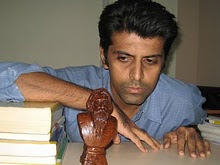Today is
Vishu, sort of the New Year in Kerala. And it is a
birthday too - this blog began on a Vishu day, a round 10 years ago.
Let me first quote a bit of sagely advice that came in y'day from Gyani:
“For Decade Two, you could consider adding the odd picture, unless you want to stick to the Paul Dirac style”.
This two-part post shall comprise fragments touching upon several subjects one wrote about during the last decade.
Narayam:
In the very first post here, I had said: “For several weeks, finding a suitable name for this blog was a bother. Then ‘Anamika’ sort of hurled into view….” In a later post I confessed: “’Anamika’ (= the nameless) marks my failure to find a good name for this blog”.
Now is the time to let my readers in on a secret - I had actually thought of a name, albeit a couple of years before this blog began; the idea then was to start up a website as a repository of my random notes – since mid-1990s, I have been a ‘writer of sorts’, writing mostly travel notes, initially in Malayalam and switching to English around Y2K. The name found for the website (which never got started) was ‘Narayam’ (prounounced ‘nah-rah-yum’). As per Wiki, a narayam is a traditional Keralan and South Asian writing instrument; it is a metallic nail used to scratch letters on to palm leaves (it is also called an ezhuthaani = ezhuthu + aani, literally, the writing nail).
Aside: Wiki says the narayam was a very versatile tool - a Desi equivalent to the Swiss Army knife. For example, it was the weapon used in the murder of Annavayyan, a key episode in the classic romance 'Dharmaraja'.
Though very similar sounding to 'Narayana' (one of Vishnu’s many names), the Malayalam word ‘Narayam’ looks like a derivative of the Sanskrit ‘naracha’ which I have seen used as a synonym for arrow, dart or nail. In Malayalam, the tap root of a plant (the main root, growing vertically down) is called the ‘narayaveru’ or ‘aaniveru’ – here maybe because like a dart, this root goes straight down. Likewise, the ‘aanikkallu’ (kallu means stone) appears to point to the most basic unit(s) of an old style stone foundation.
I could not recall 'narayam' when starting up this blog in what could only be called a lousy memory slip. Anamika is not a bad name but Narayam would have been apter. Of course, it can be argued, the rambling and desultory nature of this blog has been nothing like the tap root or the nail that goes straight to the core of things. But it is also true that in its role of a writing instrument, the nail merely scratches all over the surface! And some of my readers have observed that despite all its wanderings, the blog has always had a tap-root like anchor -
Kerala(*).
Irinjalakuda, Changampuzha and SK
“Irinjalakuda, Koodalmanikyam, Thachudayakaimal – wow, such beautiful words, so musical”. Long ago, while a student at Christ College in the small town of Irinjalakuda, I heard this ecstatic remark; Our Malayalam teacher had attributed it to the brilliant late poet Changampuzha. Several years ago, I started a post here on Memories of Irinjalakuda with this quote.
Another claimant to the quote has just swum into view; S K Pottekkat writes in his ‘Ente Vazhiyambalangal’ (my free translation):
Being both first-time visitors to Irinjalakuda, Changampuzha and I took an exploratory walk around the town …. We were now at the gateway to the Koodalmanikyam temple.
“The legends surrounding this temple are of a fantastic nature; but we certainly are on hallowed ground - where music and fine arts are eternally locked in a divine embrace!” Chengampuzha said.
“Truly, just hear those names, Irinjalakuda, Koodalmanikyam, Thachudayakaimal… Don’t they sound so lyrical?” I remarked.
“Hmm, not just the names, the glorious pulchritude of the place finds its highest expression in the looks and gait of its damsels!” said Changampuzha.
Chakka - and a Gentleman from Aluva:
Last summer I had written here about chakka or jackfruit and mentioned the two common strains of jackfruit, the varikka and the koozha, signing off a remark:
“I happen to know a gentlemen hailing from Aluva (near Cochin) who eschews the varikka and feasts on the koozha”.
Yesterday, I happened to hear about a certain Mr. James Joseph. A former Mallu-American, he was a successful manager with Microsoft. During a holiday spent at Aluva, his little daughter took a strong liking to chakka and said to him: “Dad, it would be nice if we could get such gorgeous fruits to eat everyday!” and, long story short, Mr. James now runs a burgeoning fruit processing company with strong focus on chakka products.
---------------------
(*)Note: Vimal suggests the variant: 'Nararum', a cocktail of 'Na', 'Ra' and 'Rum', the first two being the opening syllables of the two halves of my name and the last, my favorite tipple.



